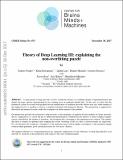| dc.contributor.author | Poggio, Tomaso | |
| dc.contributor.author | Kawaguchi, Kenji | |
| dc.contributor.author | Liao, Qianli | |
| dc.contributor.author | Miranda, Brando | |
| dc.contributor.author | Rosasco, Lorenzo | |
| dc.contributor.author | Boix, Xavier | |
| dc.contributor.author | Hidary, Jack | |
| dc.contributor.author | Mhaskar, Hrushikesh | |
| dc.date.accessioned | 2018-01-01T00:08:27Z | |
| dc.date.available | 2018-01-01T00:08:27Z | |
| dc.date.issued | 2017-12-30 | |
| dc.identifier.uri | http://hdl.handle.net/1721.1/113003 | |
| dc.description.abstract | THIS MEMO IS REPLACED BY CBMM MEMO 90
A main puzzle of deep networks revolves around the absence of overfitting despite overparametrization and despite the large capacity demonstrated by zero training error on randomly labeled data. In this note, we show that the dynamical systems associated with gradient descent minimization of nonlinear networks behave near zero stable minima of the empirical error as gradient system in a quadratic potential with degenerate Hessian. The proposition is supported by theoretical and numerical results, under the assumption of stable minima of the gradient.
Our proposition provides the extension to deep networks of key properties of gradient descent methods for linear networks, that as, suggested in (1), can be the key to understand generalization. Gradient descent enforces a form of implicit regular- ization controlled by the number of iterations, and asymptotically converging to the minimum norm solution. This implies that there is usually an optimum early stopping that avoids overfitting of the loss (this is relevant mainly for regression). For classification, the asymptotic convergence to the minimum norm solution implies convergence to the maximum margin solution which guarantees good classification error for “low noise” datasets.
The implied robustness to overparametrization has suggestive implications for the robustness of deep hierarchically local networks to variations of the architecture with respect to the curse of dimensionality. | en_US |
| dc.description.sponsorship | This work was supported by the Center for Brains, Minds and Machines (CBMM), funded by NSF STC award CCF - 1231216. | en_US |
| dc.language.iso | en_US | en_US |
| dc.publisher | arXiv | en_US |
| dc.relation.ispartofseries | CBMM Memo Series;073 | |
| dc.rights | Attribution-NonCommercial-ShareAlike 3.0 United States | * |
| dc.rights.uri | http://creativecommons.org/licenses/by-nc-sa/3.0/us/ | * |
| dc.title | Theory of Deep Learning III: explaining the non-overfitting puzzle | en_US |
| dc.type | Technical Report | en_US |
| dc.type | Working Paper | en_US |
| dc.type | Other | en_US |
| dc.identifier.citation | arXiv:1801.00173 | en_US |
